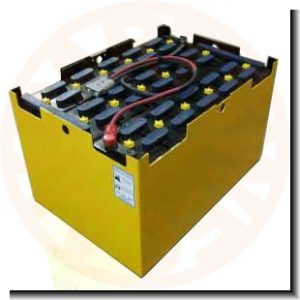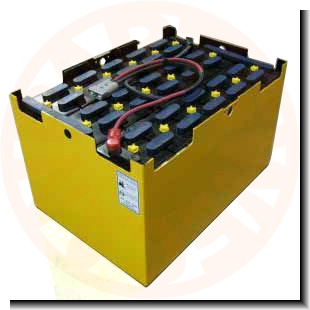Common Forklift Fuel Options
One good thing about internal combustion forklifts is that there are a number of fuel options you can use depending on your needs. Issues that a fleet manager may want to consider when selecting a fuel type is cost, environmental issues, and storage. If you happen to be using electric forklifts, you also have alternatives because there are a variety of batteries that operate differently. In selecting the proper battery, concerns could include costs, charging issues, and battery weight causing the possible need for a counterbalance for the forklift.

Forklift battery.
(Courtesy:Charles Green at flickr.com)
As far as batteries are concerned, there are two fuel options –- lead acid and lithium ion.
Lead Acid Batteries
Electric forklifts that use a lead acid battery requires a single battery or fuel cell that then supplies energy to the motor of the lift. A major benefit of this type of battery, which is also the case for the lithium ion battery, is that there is zero exhaust emissions. Other benefits of lead acid batteries include:
• Environmentally friendly
• Offers longer lifespan to an electric forklift
• Produces a low level of noise
• A lower center of gravity and more stability for forklifts that use it
• Simpler operator controls
Disadvantages associated with lead acid batteries include:
• It takes the battery 8 hours to recharge and cool down
• Expensive spare batteries will be necessary if you run a 24-hour operation
• Longer down times when charging the battery
• More up front cost for battery recharge stations
Lithium Ion Batteries
One feature of lithium ion batteries that tend to excite forklift fleet managers is its innovative technology. Other benefits include:
• Consistent power and voltage through a full charge
• Fast charging speeds and cooling down periods
• Opportunity charging throughout a shift that prevent battery changeovers
• One lithium ion battery replaces up to three lead acid batteries, thus they are less costly
• No charging room is required to charge them, reducing additional auxiliary costs
• These batteries are maintenance free and require no water, equalizing or cleaning
Disadvantages of lithium ion batteries include:
• Higher up front costs for smaller operations
• Disposing them can cause higher recycling costs
• They weigh less than lead acid batteries causing the need for a counterbalance to be added to particular forklifts
There are two fuel options for internal combustion forklifts. They include LPG gas and diesel. Each type of fuel has its own advantages and disadvantages.
LPG Gas
Advantage of LPG gas include:
• LPG is widely and easily available
• Can be used indoors or outdoors, thus very versatile
• Fast to refuel compared to recharging times for battery powered forklifts
• No separate batteries or battery charging rooms required, thus saving on costs.
Disadvantages of LPG gas include:
• Requires outdoor storage areas, which means additional costs
• LPG tank obstructs the rear view of the forklift operator
• More costly compared to battery powered forklifts
Diesel
Forklifts energized with diesel are commonly heavier and have a higher ground clearance, making them ideal for working outdoors on uneven surfaces. The power supplied by the diesel engine offers everything one would need to deal with extremely heavy loads.
Other advantages include:
• The lifts have more torque, making them ideal for lifting higher capacity loads
• The internals are less complicated, making them more reliable
• Diesel lasts longer when compared to other fuels
• Can be refueled by a bowser, which is similar to a gas station making refueling faster.
Disadvantages of diesel include:
• More costly compared to LPG gas, depending on location
• Diesel fuel engines are generally noisier
• EPA requires standard fuel reserve storage rooms, adding more costs
• More maintenance due to emissions, oil and filter changes
• More reinforced support in operating areas to deal with fully loaded lift
• Fuel emission limits use to open or well ventilated areas
(Source: hflifttrucks.co.uk)

